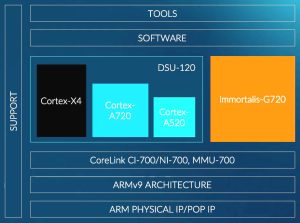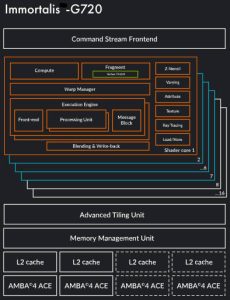The 5th generation is “designed as the most efficient GPU architecture that Arm has ever created [and] redefines parts of the graphics pipeline to reduce memory bandwidth enabling high geometry games and real-time 3D applications, while also bringing smoother game-play and complex PC and console-like experiences to mobile”, according to the company. “Deferred vertex shading is a graphics feature introduced in the 5th generation that redefines the data flow, which enables partners to scale for larger core counts and higher performance points.”
 The high-end Immortalis-G720 is intended to work alongside CPU clusters including Arm’s Cortex-X4, also announced this week and, said Arm, delivers 15% performance and efficiency improvements over its previous flagship, G715 “as well as a 40% uplift in system-level efficiency, leading to higher quality graphics for more immersive visual experiences”.
The high-end Immortalis-G720 is intended to work alongside CPU clusters including Arm’s Cortex-X4, also announced this week and, said Arm, delivers 15% performance and efficiency improvements over its previous flagship, G715 “as well as a 40% uplift in system-level efficiency, leading to higher quality graphics for more immersive visual experiences”.
As well as the addition of the deferred vertex shading geometry pipeline, G720 supports tiles up to 64×64 compared with 32×32 for G715, has increased blending throughput for MSAA (multi-sample anti-aliasing) use, has increased texture-mapper throughput for 64bpp content, and the ray-tracing unit can be power-gated.
Mali-G720 is similar to Immortalis-G720, with one major difference being that Mali branded G720 GPUs are limited to a maximum of nine shader cores, while Immortalis versions can have 10 or more.
Mali-G620 GPUs, with one to five shader cores, traded performance for better power consumption and a smaller footprint. They “inherit premium features from Mali-G720, such as deferred vertex shading,” said Arm.

